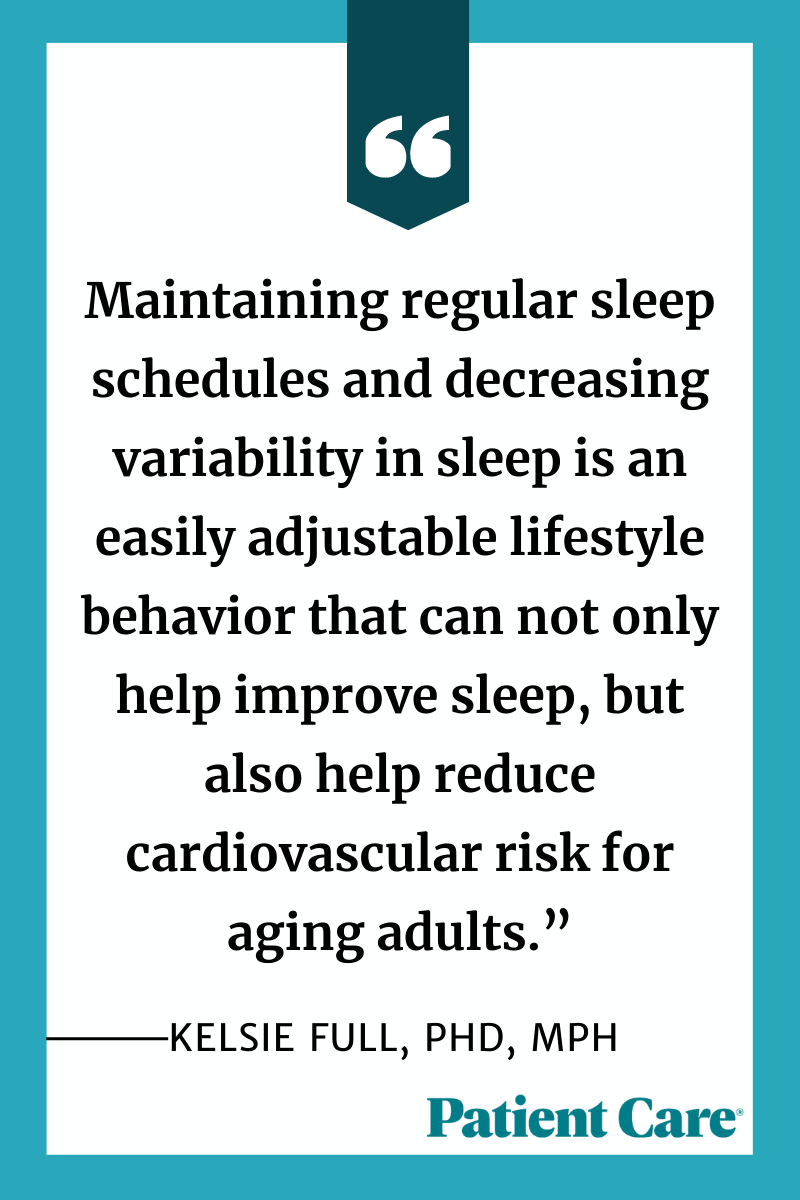- Clinical Technology
- Adult Immunization
- Hepatology
- Pediatric Immunization
- Screening
- Psychiatry
- Allergy
- Women's Health
- Cardiology
- Pediatrics
- Dermatology
- Endocrinology
- Pain Management
- Gastroenterology
- Infectious Disease
- Obesity Medicine
- Rheumatology
- Nephrology
- Neurology
- Pulmonology
Irregular Sleeping Habits Associated with Measures of Subclinical Atherosclerosis in New Study
Sleep duration irregularity was associated with measures of subclinical atherosclerosis in a racially and ethnically diverse study of more than 2000 adults.

Sleep duration irregularity was associated with measures of subclinical atherosclerosis in a large, racially, and ethnically diverse, community-based cohort study published in the Journal of the American Heart Association.
Specifically, older adults with greater sleep duration irregularity (standard deviation [SD] >120 minutes) were more likely to have high coronary artery calcium (CAC) burden and abnormal ankle‐brachial index (ABI) than those with more regular sleep duration (SD ≥60 minutes).
“This study is one of the first investigations to provide evidence of a connection between irregular sleep duration and irregular sleep timing and atherosclerosis,” said lead author Kelsie Full, PhD, MPH, assistant professor of medicine, Division of Epidemiology, Vanderbilt University Medical Center, Nashville, Tennessee, in an American Heart Association press release. “Maintaining regular sleep schedules and decreasing variability in sleep is an easily adjustable lifestyle behavior that can not only help improve sleep, but also help reduce cardiovascular risk for aging adults.”
To gain more insight into the associations of sleep regularity with atherosclerosis, Full and colleagues examined participant data from the Multi-Ethnic Study of Atherosclerosis (MESA). Participants from MESA included adults aged 45-84 years who were free of clinical cardiovascular disease (CVD) recruited from 6 US communities: St. Paul, Minnesota; Baltimore City and Baltimore County, Maryland; Chicago; Forsyth County, North Carolina; Los Angeles County, California; and Northern Manhattan and the Bronx, New York.
Overall, 2032 participants (mean age, 68.6 years) were included in the current analysis. Just over half of the participants were women (53.6%), and 37.9% identified as White, 27.6% as Black or African American, 23.4% as Hispanic American, and 11.1% as Chinese American.

Between 2010 and 2013, participants completed 7-day wrist actigraphy and completed a sleep diary for 7 consecutive days during the same period. Subclinical atherosclerosis was assessed as CAC, carotid plaque presence, carotid intima-media thickness, and ABI. Sleep regularity was quantified by the 7-day within-person SD of sleep duration and onset timing, according to the study.
Final estimates of subclinical atherosclerotic risk were adjusted for demographics, CVD risk factors, and other objectively assessed sleep variables including obstructive sleep apnea (OSA), sleep duration, and sleep fragmentation.
Participants were categorized into the following quartiles of sleep duration SD:
- ≤60 minutes
- 61-90 minutes
- 91-120 minutes
- >120 minutes
Regular sleep duration was defined as a SD of 60 minutes, and participants in this cohort were used as the reference arm.
Findings
Across the 7-day data collection period, approximately 38% of participants had sleep duration SD >90 minutes, of whom 18% had sleep duration SD >120 minutes, according to the research team.
After adjustment, investigators found that compared with participants with regular sleep durations (SD ≤60 minutes), those with greater sleep duration irregularity (SD >120 minutes) were more likely to have high CAC burden (Agatston score of >300; prevalence ratio [PR] 1.33; 95% CI, 1.03-1.71) and abnormal ABI, defined for the purpose of the study as <0.9 (PR 1.75; 95% CI, 1.03-2.95).
Compared with participants with more regular sleep timing—defined as SD ≤30 minutes— those with irregular sleep timing (SD >90 minutes) were more likely to have high CAC burden (PR 1.39; 95% CI, 1.07–1.82).
Moreover, the association between regular sleep timing and lower risk for CAC and abnormal ABI remained after adjustment for CVD risk factors, average sleep duration, OSA, and sleep fragmentation, according to the results. Researchers did not observe an association between sleep duration regularity and abnormal carotid intima‐media thickness.
“The development of atherosclerosis is a long process, allowing time for intervention before plaques have formed and hardened and can cause severe stenosis or rupture. Encouraging maintenance of regular sleep schedules with consistent sleep durations may be an important part of lifestyle recommendations provided in clinical practice for the prevention of CVD,” concluded Full and colleagues.
Reference: Full K, Huang T, Shah NA, et al. Sleep irregularity and subclinical markers of cardiovascular disease: The multi‐ethnic study of atherosclerosis. J Am Heart Assoc. Published online February 15, 2023. doi:10.1161/JAHA.122.027361.
